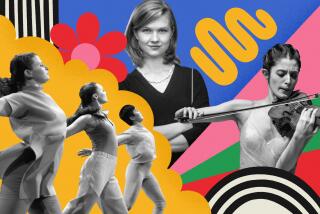At Twilight, a Retrospective of Isaac Stern Recordings
- Share via
We are in Sony Classical’s debt for giving us the first major retrospective of the recording career of Isaac Stern, and for doing so while the violinist--who recently reached his 70th birthday--is still publicly active rather than a memory.
These two 3-CD sets, at mid-price, are important for presenting Stern as artist rather than icon, as one of the century’s major violinists rather than as the savior of Carnegie Hall, unofficial Israeli minister of culture, and one of the best friends a young violinist could have--important as those accomplishments may be.
While Stern can clearly still hold his own, as witness the recently released Schubert music for violin and piano, with Daniel Barenboim (also for Sony), there is a combination of intensity and technical command in these early recordings--the period covered is 1946 through 1957--unlikely to be duplicated by today’s septuagenarian.
The principal attractions are in Volume II (45956), beginning chronologically with the toothsome kitsch of Sarasate’s “Zigeunerweisen,” recorded in 1946 with a studio orchestra under Franz Waxman’s direction for the soundtrack of a Hollywood soaper in which John Garfield’s violin was played, offscreen, by the then 25-year-old Isaac Stern.
The performance is so fiery and rhythmically exacting that one might think its soloist considered it the most important work in the repertory--which is perhaps the only way to perform anything. Stern, by the way, provides the witty, chatty annotations.
Dramatic intensity and glittering, voluminous tone, achieved through plenty of bow pressure and a fast, tight vibrato, characterize the playing throughout. In most instances, and for this taste most notably in the 1951 Sibelius Concerto--a strong partnership with Sir Thomas Beecham and the Royal Philharmonic--Stern refreshes familiar music with his joy-of-discovery passion.
The gems, however, are of more recent vintage: the two Prokofiev Concertos, recorded during the late-1950s, an invigorating blend in Stern’s hands of Romantic ardor and 20th-Century agitation. And here the violinist again finds exceptionally sympathetic support--rather than simply a sonic cushion on which to ride--from the New York Philharmonic under Dimitri Mitropoulos in the First Concerto, Leonard Bernstein in the Second.
Then, too, no one should be without the first-ever recording (1956) of Bernstein’s Serenade, commissioned by Stern and played here with craggy energy under the composer’s baton. Volume I (45952) has its enticements, too, including a fiercely unsentimental Brahms Violin Concerto derived from the 1951 London sessions with Beecham, and a dimly recorded (in 1954) but highly dramatic Brahms Double Concerto, with cellist Leonard Rose and the New York Philharmonic under Bruno Walter’s noble direction.
The 18th-Century repertory included in Volume I--concertos by Bach, Vivaldi, Mozart and Haydn--calls for a lighter touch, in terms both of tone and emotion, than Stern brought to it then. This 1950 Mozart G-major Concerto, in which the soloist also directs the ensemble, suffers markedly in comparison to Stern’s stylish 1961 re-make with George Szell and the Cleveland Orchestra, available as part of a two-CD CBS set of the four authenticated Mozart violin concertos (42494).
That Stern has in the twilight of his great career learned how to listen and follow as well as dictate and lead is indicated in a new release of Rameau’s “Pieces de clavecin en concerts” (Sony Classical 45868). The violin occupies a secondary position here, echoing or embellishing the flute line, played with casual virtuosity and unvaryingly bloated tone by Jean-Pierre Rampal, while the scampering harpsichord part is authoritatively, gleefully executed by John Steele Ritter.
Stern doesn’t seem deeply concerned with accuracy here, his intonation sagging with some frequency. But it is still heartening to find the second fiddle, so to speak, played with such youthful fervor.
More to Read
The biggest entertainment stories
Get our big stories about Hollywood, film, television, music, arts, culture and more right in your inbox as soon as they publish.
You may occasionally receive promotional content from the Los Angeles Times.










